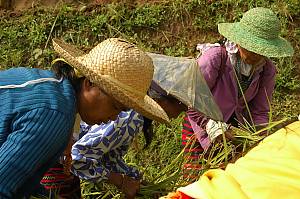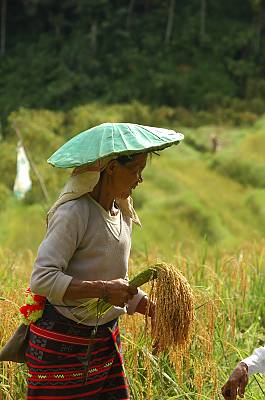Hudhud chants of the Ifugao
Inscribed in 2008 (3.COM) on the Representative List of the Intangible Cultural Heritage of Humanity (originally proclaimed in 2001)
Country(ies): Philippines
Identification
Description

- Hudhud chants of the Ifugao
- © 2008 by J. Uñalivia/NCCA-IHC
The Hudhud consists of narrative chants traditionally performed by the Ifugao community, which is well known for its rice terraces extending over the highlands of the northern island of the Philippine archipelago. It is practised during the rice sowing season, at harvest time and at funeral wakes and rituals. Thought to have originated before the seventh century, the Hudhud comprises more than 200 chants, each divided into 40 episodes. A complete recitation may last several days.
Since the Ifugao’s culture is matrilineal, the wife generally takes the main part in the chants, and her brother occupies a higher position than her husband. The language of the stories abounds in figurative expressions and repetitions and employs metonymy, metaphor and onomatopoeia, rendering transcription very difficult. Thus, there are very few written expressions of this tradition. The chant tells about ancestral heroes, customary law, religious beliefs and traditional practices, and reflects the importance of rice cultivation. The narrators, mainly elderly women, hold a key position in the community, both as historians and preachers. The Hudhud epic is chanted alternately by the first narrator and a choir, employing a single melody for all the verses.
The conversion of the Ifugao to Catholicism has weakened their traditional culture. Furthermore, the Hudhud is linked to the manual harvesting of rice, which is now mechanized. Although the rice terraces are listed as a World Heritage Site, the number of growers has been in constant decline.The few remaining narrators, who are already very old, need to be supported in their efforts to transmit their knowledge and to raise awareness among young people.
Slideshow
Video
These videos (and many more) can also be consulted through the UNESCO Archives Multimedia website
Safeguarding project (05-2003/04-2008)
Well known for their rice terraces and extensive knowledge of rice cultivation, the Ifugao perform the Hudhud chants during the sowing and harvest seasons and at funeral wakes. The chants are transmitted orally and tell about ancestral heroes, customary law, traditional practices and religious beliefs.
The project aims to collect, document and record the Hudhud as well as integrate it into local school programmes, create schools in order to teach it and ensure its transmission as a living tradition to new generations of practitioners. Finally, the project will promote the Hudhud through chanting competitions, performances and exhibitions. The preliminary documentary work has begun. Teaching the Hudhud has become an integral part of the provincial school curriculum and those/the schools that will be responsible for the transmission of the Hudhud have already been identified.


























